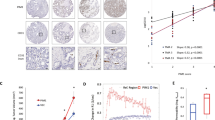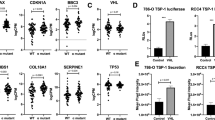Abstract
Loss of the promyelocytic leukaemia (PML) tumour suppressor has been observed in several human cancers. The tumour-suppressive function of PML has been attributed to its ability to induce growth arrest, cellular senescence and apoptosis. Here we identify PML as a critical inhibitor of neoangiogenesis (the formation of new blood vessels) in vivo, in both ischaemic and neoplastic conditions, through the control of protein translation. We demonstrate that in hypoxic conditions PML acts as a negative regulator of the synthesis rate of hypoxia-inducible factor 1α (HIF-1α) by repressing mammalian target of rapamycin (mTOR). PML physically interacts with mTOR and negatively regulates its association with the small GTPase Rheb by favouring mTOR nuclear accumulation. Notably, Pml-/- cells and tumours display higher sensitivity both in vitro and in vivo to growth inhibition by rapamycin, and lack of PML inversely correlates with phosphorylation of ribosomal protein S6 and tumour angiogenesis in mouse and human tumours. Thus, our findings identify PML as a novel suppressor of mTOR and neoangiogenesis.
This is a preview of subscription content, access via your institution
Access options
Subscribe to this journal
Receive 51 print issues and online access
$199.00 per year
only $3.90 per issue
Buy this article
- Purchase on Springer Link
- Instant access to full article PDF
Prices may be subject to local taxes which are calculated during checkout





Similar content being viewed by others
References
Hanahan, D. & Folkman, J. Patterns and emerging mechanisms of the angiogenic switch during tumorigenesis. Cell 86, 353–364 (1996)
Ferrara, N. Vascular endothelial growth factor: basic science and clinical progress. Endocr. Rev. 25, 581–611 (2004)
Semenza, G. L. HIF-1 and tumor progression: pathophysiology and therapeutics. Trends Mol. Med. 8, S62–S67 (2002)
de The, H. et al. The PML-RARα fusion mRNA generated by the t(15;17) translocation in acute promyelocytic leukemia encodes a functionally altered RAR. Cell 66, 675–684 (1991)
Goddard, A. D., Borrow, J., Freemont, P. S. & Solomon, E. Characterization of a zinc finger gene disrupted by the t(15;17) in acute promyelocytic leukemia. Science 254, 1371–1374 (1991)
Kakizuka, A. et al. Chromosomal translocation t(15;17) in human acute promyelocytic leukemia fuses RARα with a novel putative transcription factor, PML. Cell 66, 663–674 (1991)
Pandolfi, P. P. et al. Structure and origin of the acute promyelocytic leukemia myl/RARα cDNA and characterization of its retinoid-binding and transactivation properties. Oncogene 6, 1285–1292 (1991)
Rego, E. M. et al. Role of promyelocytic leukemia (PML) protein in tumor suppression. J. Exp. Med. 193, 521–529 (2001)
Salomoni, P. & Pandolfi, P. P. The role of PML in tumor suppression. Cell 108, 165–170 (2002)
Wang, Z. G. et al. PML is essential for multiple apoptotic pathways. Nature Genet. 20, 266–272 (1998)
Wang, Z. G. et al. Role of PML in cell growth and the retinoic acid pathway. Science 279, 1547–1551 (1998)
Trotman, L. C. et al. Identification of a tumour suppressor network opposing nuclear Akt function. Nature 441, 523–527 (2006)
Koken, M. H. et al. The PML growth-suppressor has an altered expression in human oncogenesis. Oncogene 10, 1315–1324 (1995)
Gambacorta, M. et al. Heterogeneous nuclear expression of the promyelocytic leukemia (PML) protein in normal and neoplastic human tissues. Am. J. Pathol. 149, 2023–2035 (1996)
Zhang, P. et al. Lack of expression for the suppressor PML in human small cell lung carcinoma. Int. J. Cancer 85, 599–605 (2000)
Gurrieri, C. et al. Loss of the tumor suppressor PML in human cancers of multiple histologic origins. J. Natl Cancer Inst. 96, 269–279 (2004)
Lin, H. K., Bergmann, S. & Pandolfi, P. P. Cytoplasmic PML function in TGF-β signalling. Nature 431, 205–211 (2004)
Takahashi, Y., Lallemand-Breitenbach, V., Zhu, J. & de The, H. PML nuclear bodies and apoptosis. Oncogene 23, 2819–2824 (2004)
Marti, H. H. & Risau, W. Angiogenesis in ischemic disease. Thromb. Haemost. 82 (suppl. 1), 44–52 (1999)
Rafii, S. & Lyden, D. Therapeutic stem and progenitor cell transplantation for organ vascularization and regeneration. Nature Med. 9, 702–712 (2003)
Rabbany, S. Y., Heissig, B., Hattori, K. & Rafii, S. Molecular pathways regulating mobilization of marrow-derived stem cells for tissue revascularization. Trends Mol. Med. 9, 109–117 (2003)
Lyden, D. et al. Impaired recruitment of bone-marrow-derived endothelial and hematopoietic precursor cells blocks tumor angiogenesis and growth. Nature Med. 7, 1194–1201 (2001)
Amano, K. et al. Mechanism for IL-1β-mediated neovascularization unmasked by IL-1β knock-out mice. J. Mol. Cell. Cardiol. 36, 469–480 (2004)
Semenza, G. L. Targeting HIF-1 for cancer therapy. Nature Rev. Cancer 3, 721–732 (2003)
Kaelin, W. G. Jr. How oxygen makes its presence felt. Genes Dev. 16, 1441–1445 (2002)
Brahimi-Horn, C. & Pouyssegur, J. When hypoxia signalling meets the ubiquitin-proteasomal pathway, new targets for cancer therapy. Crit. Rev. Oncol. Hematol. 53, 115–123 (2005)
Arsham, A. M., Howell, J. J. & Simon, M. C. A novel hypoxia-inducible factor-independent hypoxic response regulating mammalian target of rapamycin and its targets. J. Biol. Chem. 278, 29655–29660 (2003)
Brugarolas, J. et al. Regulation of mTOR function in response to hypoxia by REDD1 and the TSC1/TSC2 tumor suppressor complex. Genes Dev. 18, 2893–2904 (2004)
Liu, L. et al. Hypoxia-induced energy stress regulates mRNA translation and cell growth. Mol. Cell 21, 521–531 (2006)
Dufner, A. & Thomas, G. Ribosomal S6 kinase signaling and the control of translation. Exp. Cell Res. 253, 100–109 (1999)
Harrington, L. S., Findlay, G. M. & Lamb, R. F. Restraining PI3K: mTOR signalling goes back to the membrane. Trends Biochem. Sci. 30, 35–42 (2005)
Martin, D. E. & Hall, M. N. The expanding TOR signaling network. Curr. Opin. Cell Biol. 17, 158–166 (2005)
Long, X., Ortiz-Vega, S. & Avruch, J. Rheb binding to mammalian target of rapamycin (mTOR) is regulated by amino acid sufficiency. J. Biol. Chem. 280, 23433–23436 (2005)
Kim, J. E. & Chen, J. Cytoplasmic-nuclear shuttling of FKBP12-rapamycin-associated protein is involved in rapamycin-sensitive signaling and translation initiation. Proc. Natl Acad. Sci. USA 97, 14340–14345 (2000)
Park, I. H., Bachmann, R., Shirazi, H. & Chen, J. Regulation of ribosomal S6 kinase 2 by mammalian target of rapamycin. J. Biol. Chem. 277, 31423–31429 (2002)
Paglin, S. et al. Rapamycin-sensitive pathway regulates mitochondrial membrane potential, autophagy, and survival in irradiated MCF-7 cells. Cancer Res. 65, 11061–11070 (2005)
Jensen, K., Shiels, C. & Freemont, P. S. PML protein isoforms and the RBCC/TRIM motif. Oncogene 20, 7223–7233 (2001)
Corada, M. et al. A monoclonal antibody to vascular endothelial-cadherin inhibits tumor angiogenesis without side effects on endothelial permeability. Blood 100, 905–911 (2002)
Liao, F. et al. Selective targeting of angiogenic tumor vasculature by vascular endothelial-cadherin antibody inhibits tumor growth without affecting vascular permeability. Cancer Res. 62, 2567–2575 (2002)
Zhu, J., Lallemand-Breitenbach, V. & de The, H. Pathways of retinoic acid- or arsenic trioxide-induced PML/RARα catabolism, role of oncogene degradation in disease remission. Oncogene 20, 7257–7265 (2001)
Lavau, C. et al. The acute promyelocytic leukaemia-associated PML gene is induced by interferon. Oncogene 11, 871–876 (1995)
Chelbi-Alix, M. K. et al. Induction of the PML protein by interferons in normal and APL cells. Leukemia 9, 2027–2033 (1995)
Sawyers, C. L. Will mTOR inhibitors make it as cancer drugs? Cancer Cell 4, 343–348 (2003)
Vignot, S., Faivre, S., Aguirre, D. & Raymond, E. mTOR-targeted therapy of cancer with rapamycin derivatives. Ann. Oncol. 16, 525–537 (2005)
Bernardi, R. et al. PML regulates p53 stability by sequestering Mdm2 to the nucleolus. Nature Cell Biol. 6, 665–672 (2004)
Sarbassov, D. D. et al. Rictor, a novel binding partner of mTOR, defines a rapamycin-insensitive and raptor-independent pathway that regulates the cytoskeleton. Curr. Biol. 14, 1296–1302 (2004)
Grisendi, S. et al. Role of nucleophosmin in embryonic development and tumorigenesis. Nature 437, 147–153 (2005)
Acknowledgements
We are grateful to W. Gerald for providing the prostate cancer TMAs. We thank M. Socorro Jiao and M. Drobnjak for help with immunohistochemistry, P. Burgman and S. Carlin for help with hypoxia experiments, B. Carver for help with statistical analysis, L. DiSantis, R. Hobbs and J. Clohessy for critical reading of the manuscript, and all members of the Pandolfi laboratory for comments and discussion. This work was supported by NIH grants to P.P.P.
Author information
Authors and Affiliations
Corresponding author
Ethics declarations
Competing interests
Reprints and permissions information is available at npg.nature.com/reprintsandpermissions. The authors declare no competing financial interests.
Supplementary information
Supplementary Figure 1
High Hif-1α levels and Hif-1α transcriptional activity in Pml-/- cells in hypoxia. (PDF 448 kb)
Supplementary Figure 2
High Hif-1α levels in human cell lines stably transfected with PML. (PDF 442 kb)
Supplementary Figure 3
High S6K phosphorylation in Pml-/- cells in hypoxia and serum starvation. (PDF 526 kb)
Supplementary Figure 4
Inhibition of mTOR activity by PML overexpression. (PDF 1077 kb)
Supplementary Figure 5
Characterization of wt and Pml-/- transformed cells in vitro and in vivo. (PDF 411 kb)
Supplementary Notes
This file contains Supplementary Methods (Cell culture, mice and reagents; hind-limb ischemia surgery; plasmids, cell transfections and transactivation assays; real-time PCR; western blotting; TMA analysis; and statistical evaluation), Supplementary Figure Legends and additional references. (DOC 51 kb)
Rights and permissions
About this article
Cite this article
Bernardi, R., Guernah, I., Jin, D. et al. PML inhibits HIF-1α translation and neoangiogenesis through repression of mTOR. Nature 442, 779–785 (2006). https://doi.org/10.1038/nature05029
Received:
Accepted:
Issue Date:
DOI: https://doi.org/10.1038/nature05029
This article is cited by
-
iASPP is essential for HIF-1α stabilization to promote angiogenesis and glycolysis via attenuating VHL-mediated protein degradation
Oncogene (2022)
-
Neddylation blockade induces HIF-1α driven cancer cell migration via upregulation of ZEB1
Scientific Reports (2020)
-
Location-specific inhibition of Akt reveals regulation of mTORC1 activity in the nucleus
Nature Communications (2020)
-
Cellular adaptation to hypoxia through hypoxia inducible factors and beyond
Nature Reviews Molecular Cell Biology (2020)
-
Expression and prognostic significance of pyruvate dehydrogenase kinase 1 in bladder urothelial carcinoma
Virchows Archiv (2020)
Comments
By submitting a comment you agree to abide by our Terms and Community Guidelines. If you find something abusive or that does not comply with our terms or guidelines please flag it as inappropriate.



